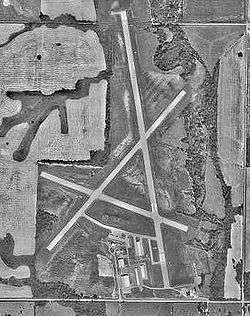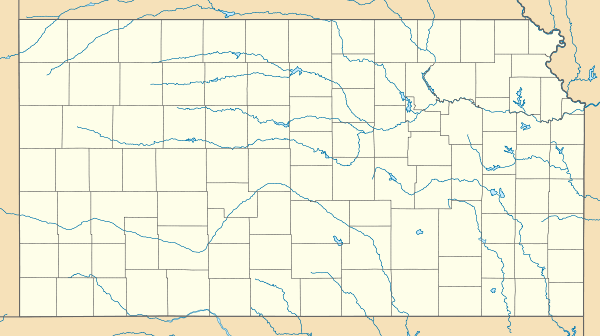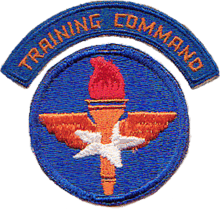Atkinson Municipal Airport
Atkinson Municipal Airport (IATA: PTS, ICAO: KPTS, FAA LID: PTS) is a city-owned, public-use airport located three nautical miles (6 km) northwest of the central business district of Pittsburg, a city in Crawford County, Kansas, United States.[1] It is included in the National Plan of Integrated Airport Systems for 2011–2015, which categorized it as a general aviation facility.[2]
Atkinson Municipal Airport | |||||||||||||||
|---|---|---|---|---|---|---|---|---|---|---|---|---|---|---|---|
 USGS 1991 orthophoto | |||||||||||||||
| Summary | |||||||||||||||
| Airport type | Public | ||||||||||||||
| Owner | City of Pittsburg | ||||||||||||||
| Serves | Pittsburg, Kansas | ||||||||||||||
| Elevation AMSL | 950 ft / 290 m | ||||||||||||||
| Coordinates | 37°26′58″N 094°43′52″W | ||||||||||||||
| Map | |||||||||||||||
 PTS Location of airport in Kansas | |||||||||||||||
| Runways | |||||||||||||||
| |||||||||||||||
| Statistics (2009) | |||||||||||||||
| |||||||||||||||
History
Established as Pittsburg Airport in April 1940. Taken over by the United States Army Air Force on May 25, 1942 as a basic (level 1) pilot training airfield. Assigned to USAAF Gulf Coast Training Center (later Central Flying Training Command). Conducted contract basic flying training by McFarland Flying Service. Fairchild PT-19s were the primary trainers used. Also had several PT-17 Stearmans and a few P-40 Warhawks assigned. Flight school also operated two auxiliary airfields in the local area. Unpowered glider pilot training was also performed by 21st Army Air Forces Glider Training Detachment from May 1942 until February 1943
Inactivated October 20, 1944 with the drawdown of AAFTC's pilot training program and was declared surplus in 1946. Responsibility for it was given to the War Assets Administration and was eventually acquired by City of Pittsburg. [3]
Facilities and aircraft
Atkinson Municipal Airport covers an area of 742 acres (300 ha) at an elevation of 950 feet (290 m) above mean sea level. It has two runways with asphalt surfaces: 16/34 is 5,500 by 100 feet (1,676 x 30 m) and 4/22 is 4,000 by 75 feet (1,219 x 23 m).[1]
For the 12-month period ending June 23, 2009, the airport had 23,600 aircraft operations, an average of 64 per day: 99.6% general aviation and 0.4% military. At that time there were 38 aircraft based at this airport: 66% single-engine, 18% jet, 8% multi-engine, 5% ultralight, and 3% helicopter.[1]
See also
- Kansas World War II Army Airfields
- 31st Flying Training Wing (World War II)
References
- FAA Airport Master Record for PTS (Form 5010 PDF). Federal Aviation Administration. Effective May 31, 2012.
- "2011–2015 NPIAS Report, Appendix A" (PDF). National Plan of Integrated Airport Systems. Federal Aviation Administration. October 4, 2010. Archived from the original (PDF, 2.03 MB) on 2012-09-27.
-

- Shaw, Frederick J. (2004), Locating Air Force Base Sites History’s Legacy, Air Force History and Museums Program, United States Air Force, Washington DC, 2004.
- Manning, Thomas A. (2005), History of Air Education and Training Command, 1942–2002. Office of History and Research, Headquarters, AETC, Randolph AFB, Texas ASIN: B000NYX3PC
External links
| Wikimedia Commons has media related to Atkinson Municipal Airport. |
- Aerial photo as of September 1991 from USGS The National Map
- FAA Terminal Procedures for PTS, effective August 13, 2020
- Resources for this airport:
- FAA airport information for PTS
- AirNav airport information for PTS
- ASN accident history for PTS
- FlightAware airport information and live flight tracker
- SkyVector aeronautical chart for PTS
